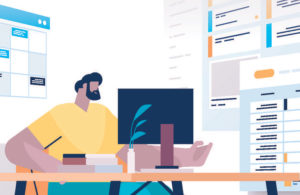Find the Right Organizational System for You
Carey Heller, PsyD
Download PDF
And Stop Trying to Fit Yourself Into a Specific App or Tool
Twenty-eight-year-old Johnny works as a software developer. He has struggled with ADHD since his early years in elementary school. ADHD impacts his ability to stay focused, be organized, and get things done without procrastinating.
 As an adult, Johnny has often been told by his parents and even his girlfriend that if he would just use a specific calendar or task list app, he would be better organized and on top of things. Despite making sporadic efforts to follow their advice and try out different apps, he has yet to find success. Each time he tried in vain to fit his organizational needs into the confines of the given apps.
As an adult, Johnny has often been told by his parents and even his girlfriend that if he would just use a specific calendar or task list app, he would be better organized and on top of things. Despite making sporadic efforts to follow their advice and try out different apps, he has yet to find success. Each time he tried in vain to fit his organizational needs into the confines of the given apps.
The principle of using a calendar or task list or other similar tools as a method to keep track of events and tasks may seem fairly simple on the surface. Several issues that can get missed, however, when someone with ADHD is trying to use a specific app to stay organized.
First, everyone is different in how they conceptualize pieces of information, prefer to visualize items, and so forth. People differ on the aesthetics of what is appealing to them. The types of information someone needs to keep track of varies as well (for example, tasks solely for them to complete, shared items with a partner, things for their kids). All these factors impact how helpful a particular calendar, task list, or other organizational app is likely to be for an individual.
So, rather than picking an app or program and trying to make it fit your own needs, it would be better to identify first what your needs are—and then seek out the best program or comprehensive system to assist.
Returning to Johnny as our example, we know he needs to keep track of many things, including:
Work
- Large work projects
- Small routine tasks
- Required meetings
- Client meetings that he schedules or gets invited to attend
- Check and respond to emails
- Return phone calls
Personal
- Pay bills
- Order household items as needed
- Do chores around the house
- Keep track of times and remember to show up when he is responsible for taking his nephew and niece to various activities
Johnny has a few preferences for a calendar or task list program:
- One that offers customization for color schemes
- An app or software program that has a task list and calendar together
- A program he can access on his phone and computer
- One that offers the option to either copy and paste or click a button to add tasks from emails to his list
Based on all of the information that Johnny needs to keep track of in a calendar, task list, or similar app system, paired with his preferences, he can now search for programs that match his needs.
Implementation and maintenance of a new system
For many people with ADHD, finding a program of interest is much easier than developing a routine of using the tools. Carefully selecting a new system that should be a good fit increases the chances of its being easier to use. But this does not mean that they will be able to use it effectively from the start.
The following tips will help you with the follow-through you’ll need when using a new app, program, or system.
- For using a task list function, it may be beneficial to include some tasks such as brushing your teeth, eating dinner, etc., that you already remember to do without needing a reminder. Having such an item in the task list can serve as a way to focus on looking at and marking off the task as completed, rather than having to both follow through and then remember to mark off items as complete.
- Some people do better by starting small and adding a few things to the task list or one type of event to the calendar, gradually adding more items as their comfort level and ability to use the system increases.
- Some people do better by adding all types of events to a calendar from the start, as well as all possible tasks or the most important ones.
- Sometimes it is not just about the specific app or program that you use, but how you have access to it. For example, maybe a specific calendar platform does not work well on your phone, but is useful on your laptop or desktop computer. Or, perhaps you get distracted by alerts on your phone, but using a smartwatch to notify you of your next event without having to access it on a phone ends up being a very helpful method for keeping yourself on schedule.
- Commit to doing an honest, thorough review and evaluation of how well your systems are working, at least weekly. Perhaps you could do this yourself, using a written checklist to assist. Otherwise, you may benefit from having a professional or close friend review the success of your systems and tweak things as needed—hopefully someone with whom you could meet weekly.
Given how many calendar, task list, and other related organizational apps are out there, you may be surprised that I have not mentioned a single specific one by name. That is actually intentional. Taking a step back from focusing on specific apps or programs, and instead looking at your own needs and preferences, will help you select the right combination of items to more effectively meet your needs.
Once you understand more about what you’re looking for, you can search for electronic calendars, task lists, or organizational systems. Use your preferences to identify the right app, program, or combination of tools that will work for you.
Step-By-Step Guide to Choosing the Right App
- Identify the types of items that you need to keep track of, such as meetings, individual tasks, projects with partners, or household chores.
- Make a list of any preferences, such as a task list, calendar, color coding, time block format option, and so forth.
- Go to the app stores and search for terms such as calendar, task list, organization, or scheduling. Review the options and see if any appeal to you and match your preferences. Review the descriptions, images available, and reviews. If necessary to reduce the number of search results, consider searching for additional terms related to your preferences, such as color coding or syncs to Google Calendar.

Step-By-Step Guide to Improving Follow-Through When Using a New App
- Decide how you are going to start using the new app. For example, you could put all possible tasks in there, just list work or personal tasks, or perhaps start with tasks pertaining to one item such as a specific work project.
- Enter the tasks, events, or other information into the app.
- Add a few tasks or events that you already remember to do (such as brushing your teeth or eating dinner) and set notifications to go off when it is time to do these things. Practice reviewing the alerts and mark the task as complete if the app permits after you have done it. Since you already are good at remembering these tasks, this will help you get in the habit of using the app—because your focus will be on using the app, not on doing the tasks.
- Do a weekly review of your use of the app. Make a checklist of things to look for (for example: am I putting all events/tasks in, am I updating it in a timely manner, am I using the notifications properly, am I still forgetting about things included in the app). To really evaluate and be honest with yourself about how it is going, you may find discussion with a family member, friend, or professional helpful. Identify changes that need to be made and write them down for review the following week
 Carey A. Heller, PsyD, is a licensed psychologist based in Maryland. He specializes in the evaluation and treatment of ADHD and executive function issues. Learn more at hellerpsychologygroup.com. The coordinator for the Montgomery County chapter of CHADD, Dr. Heller also serves on the editorial advisory board for Attention magazine.
Carey A. Heller, PsyD, is a licensed psychologist based in Maryland. He specializes in the evaluation and treatment of ADHD and executive function issues. Learn more at hellerpsychologygroup.com. The coordinator for the Montgomery County chapter of CHADD, Dr. Heller also serves on the editorial advisory board for Attention magazine.
Other Articles in this Edition
Is ADHD Related to Creativity?
LEAP: Promoting a Healthy Lifestyle
ADHD and the Myth of the Bad Parent
Know What They Need: Help Your Child Recharge and Review This Summer
Disclose Your ADHD? What to Consider First
Your Strengths Are Your Superpowers
